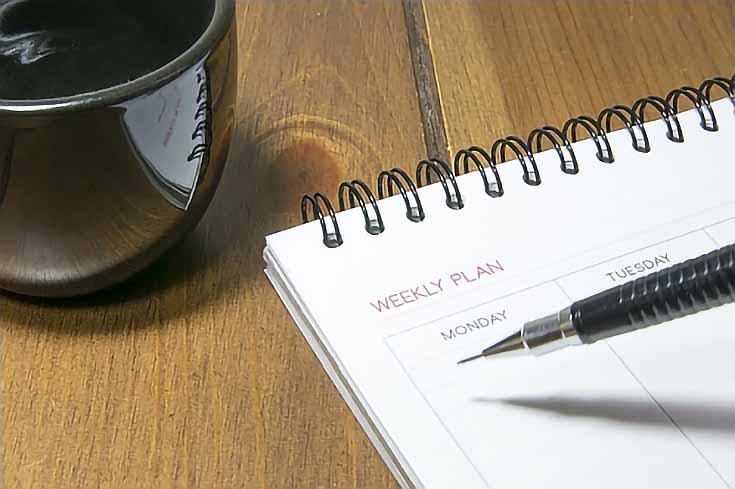When we’re young, we dream of becoming famous artists, traveling the world and making lots of great art (not to mention lots of money).
After a few years, maybe a college education and a “real job,” our dreams turn toward the time when we can retire from our day job and make art full time. World travel may no longer be part of the equation, but we do still dream of making money from our art, and having a nice little art business to help pay the bills.
For most of us who are working on that art business right now, that means wearing a lot of different hats, only one of which is an artist’s beret. You might find yourself being a bookkeeper, a marketer, an inventory manager, and requisitions specialist, all while taking care of your family and other obligations.
If you’re anything like me, you might be wondering how in the world can you do all those things without being overwhelmed?
I’ve always been a one-person show. In addition to making art, I’ve had to get my own supplies, keep inventory, do the books, and manage marketing and customer service.
This year a number of career opportunities have arisen, which is wonderful, but they’ve also added to my daily burden. I confess without embarrassment to having spent many days feeling overwhelmed. Some days, it’s been so bad, I’ve felt like I’m up to my neck in a swamp filled with alligators.
So, what to do?
In no way can I claim to have everything under control, but I can share some of the things I’ve done to ease the burdens and keep moving forward.
Step 1. Record how you spend your time
Every time I’ve been overwhelmed by the number of things to be done each day, I’ve forced myself to stop and evaluate how I spend each day. Am I watching TV when I could be making art? Am I letting the “urgent” things take over my schedule at the expense of the “important” things? Where am I duplicating effort?
It may seem like just one more thing to cram into an already busy day, but it’s vital to begin by recording what you do. Record daily activities for no less than a week. A couple of weeks is better.
Step 2. Eliminate the unnecessary
Once you have a good idea how you spend your days, look for activities you can eliminate either because they aren’t related to your business, because they duplicate or overlap another activity, or because your return on time invested isn’t very good.
Eliminating one TV show a week might give you time to create art, run the art business, and still breathe. You may find that you’d have plenty of time to do your work if you selected a couple of favorite TV shows and stopped all the rest.
Maybe you need to cut back even further. A TV fast, for a few days or a week, might free up enough time to finish some of the projects that have been hanging over your head.
Maybe your time sink is social media. Ask yourself if you really need to check Twitter every twenty minutes, or if once a day for twenty minutes would be sufficient. The solution could also be focusing on one or two social media venues and dropping the rest. You don’t need to close your accounts, but you may need to stop putting time into them.
This was actually a big change for me. I’d been trying to spend 30 minutes a day on Twitter, which not only reduced my creative time but was also a bit stressful (I don’t particularly care for any form of social media except Pinterest and blogging). Those 30 minutes usually resulted in some degree of frustration.
I still have a Twitter account, but I no longer post on it every day. Every time I publish a blog post, it’s tweeted automatically, but that’s all I’m doing. Do I miss it? Not a bit.
Do I have more time? Absolutely!
Step 3. Find ways to do two things at once
Sounds counterproductive, doesn’t it? If you do it right, though, it can be the biggest boost to productivity you’ll ever find.
I enjoy watching videos about art. Speed drawings, live streams, tutorials. But some of them take a lot of time to watch. I get to the end and have learned something, but I’ve done no art of my own.
The solution was to listen to videos while I’m drawing. I can still glance at the video when something interesting happens, but I’m also working on art.
I’ve only been doing this a week or two, but I’ve already learned that if I’m listening to a video, I can draw for much longer than if I’m working in silence. It’s amazing! (It also feels a bit like working with another artist in the studio, especially if the video is a live stream.)
I’m very much looking forward to getting a current project done, so I can post what I worked on during the live stream, like many of the other artists are doing!
You might also try music, or an art video on DVD. Or a regular movie or audiobook.
Step 4. Make a schedule
With this step, I’m pointing a finger at myself in addition to offering you a suggestion. This is the most difficult thing for me to do and stick to.
So. Make a schedule. Start with the big things, then fit the other things in around them.
Do you attend or teach a class? Block off that time first. Include preparation time. Then, schedule your drawing time for the time of day when you’re most creative. Schedule other things around that.
Are you making videos to promote your art on YouTube? Schedule in your editing time as well as filming time.
Do you maintain a blog? Decide when writing posts works best and put that into your schedule. Include some time for editing your posts, too.
Don’t forget to schedule the periodic things that must be done, also. I now plan out some time to do inventory the first of every year. I also have schedule time to prepare and file state sales taxes every quarter. That includes updating accounts, and everything else that goes with that process.
Supply runs are more difficult to schedule, but something that’s helped me is to keep a running list of supplies and then get everything in a single trip. Or buy it all online at once.
Spending one entire day shopping is better than cutting up a lot of days for shorter trips.
Step 5. Stick to your schedule
Making a schedule is the easy part. Sticking with it is where I stumble. If a drawing is going well, it’s awfully difficult to set it aside to do something else just because that’s what my schedule says I should do.
And if a drawing is going poorly, it’s just as easy to put off working on it. There’s been many a time that I’ve ignored my schedule for both reasons.
But the busier I get, the more benefit I see to maintaining a schedule, and I know—if you just give it a try!—you’ll discover the same to be true for yourself.
In the end, we all have only twenty-four in the day and each one of us has things that Must Be Done When They Must Be Done. But how you plan for, and use, your days will definitely influence how much you’re able to accomplish.
This post may contain affiliate links.




